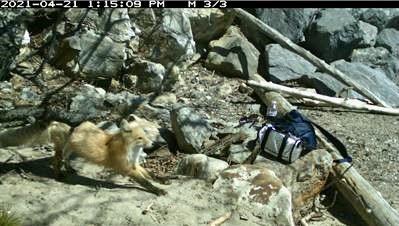
An aerial view of Lake Minnewanka/Banff & Lake Louise Tourism, Paul Zizka
Banff National Park is closing a small waterfront area of popular Lake Minnewanka to protect a red fox den.
It's the second straight year that a fox family has earmarked the site, hidden in a protective embankment among tree roots, to raise its young. The area is just north of the second boat launch in the day-use area and the goal is to keep people away from the smart but secretive foxes.
"It's a pretty senstiive time for these animals," says Dan Rafla, a human-wildlife co-existence specialist for Parks Canada. "The key message is respect their space and be part of the solution."

The Lake Minnewanka fox caught outside the den by a remote camera before the area was closed/Parks Canada
Remote cameras captured the action last spring and summer as a fox family raised four or five kits (that's just an estimate based on the number of animals caught in a photo together). A female, who didn't seem to have yet given birth, was recently spotted going in and out of the same den getting it back up to snuff for this year's brood. One shot even captures the fox taking stock of a backpack and water bottle that someone had put down on the shore before the closure and without knowing a fox was around.
"It was really a poignant photograph that really drives home the point" that people can unwittingly disturb wildlie, says Rafla. Even if you just set food on the ground and step away briefly for a selfie, a fox could snatch it.
The closure started April 23 and runs until August 15. It's marked by sandwich boards, signs and red "area closure" tape.
Red foxes — which can be shades of red, blue and black — typically get their dens in order and give birth in early spring. Eventually, the kits will start poking their heads out of the den and Rafla says they will "become more ambulatory and will leave that den site." The family will then make use of temporary "rendez-vous sites" for the kits as the parents hunt for mice, voles, ground squirrels and other small rodents, and scavenge from the kill sites of other animals.
Foxes don't tend to be active when people are around so there's nothing to lure gawkers or photographers. But with help from remote cameras, Rafla says parks staff can later see "it's quite adorable" when the skittish kits start exploring beyond the den.
Some animals — like grizzlies — have been known to den somewhat near a human presence for added protection against predators for their young. There's no way of knowing if the red foxes strategically chose the Lake Minnewanka den for this reason. On the flp side, Rafla warns that foxes are at risk of being hit on roadways or fed by humans. Even if you see "ragged" looking foxes out hunting for their young, know that "there is ample natural food" in Banff for them.
Lake Minnewanka — once three lakes until it was dammed — is about 20-kilometres (12-miles) long. There's a large parking lot, boat launch and infrastructure on the the northwest shore, as well as a private business that offers tours and boat rentals. The closure for the fox den is only about the size of 10 parking spots but does go right to the water. "It really has little impact on visitors," says Rafla.

A map showing the temporary. closure for the fox den/Parks Canada
Anyone who violates the closure can be charged under the Canada National Parks Act and fined up to $25,000 ($20,00 USD).
Park superintendents annually authorize the temporary closure of small, posted areas to keep people safe and prevent wildlife from being disturbed where important natural processes or active management are occurring.
Two other annual, larger closures are in place right now in Banff, both to protect wolves. Fairholme Range (south of Johnson Lake and north of the Trans-Canada Highway) and an area between Ranger Creek and the west end of the Hillsdale Split are closed until July 15.

 Support Essential Coverage of Essential Places
Support Essential Coverage of Essential Places



